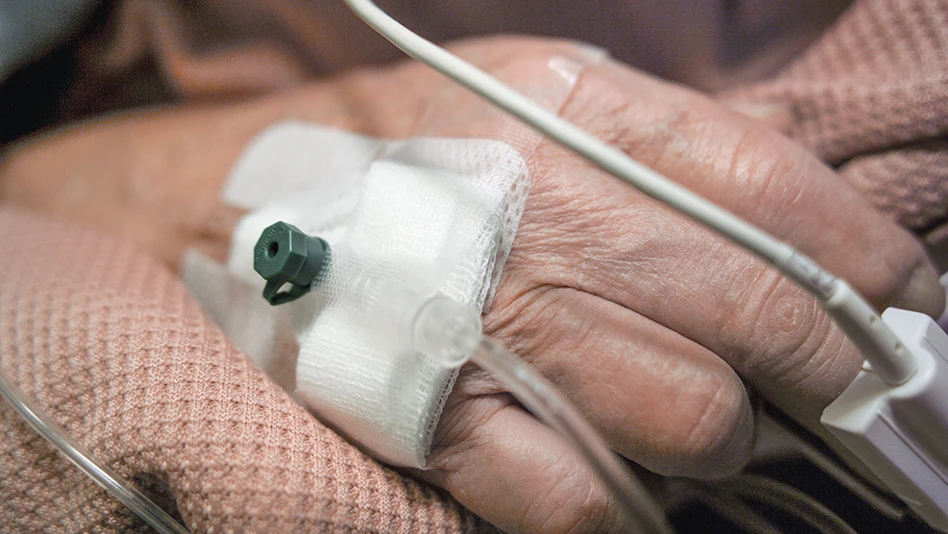
CREDIT: artimelt AG
The delicate skin of a newborn baby, the parchment-like epidermis found in the elderly, the vulnerability of an eyelid, the challenges of fixing a catheter in place, the care required when treating pressure sores – these are all situations in which the quality of an adhesive plaster or tape takes on particular importance.
In situations involving very sensitive skin, a combination of good initial adhesion and painless removal is needed. And the hot melt adhesives from the artimeltlowtrauma series offers that. They boast optimum adhesion and stay put for the intended length of time but can then be removed astonishingly painlessly without damaging the skin. The adhesives are gentle on the wound and the surrounding skin, ensuring that the wound healing process is not compromised by trauma when changing the dressing or plaster.

The right choice
Optimum peel properties are achieved thanks to the right choice of adhesive type, substrate, and application weight.
The silicone-free hot melts in the artimeltlowtrauma series use a novel thermoplastic acrylate. This offers critical advantages, as acrylates are inherently breathable. The skin under the plaster does not become moist, which has a positive effect on the wound healing process. The wound under the plaster remains moist without the issue of pooling or development of a wet interface This means that unlike with silicone-based products, the dressing does not need to be perforated.
Low-trauma adhesives are always applied with a high application weight, which makes it possible to remove the plaster gently.
The substrate also plays a considerable role in determining the properties of the final adhesive bandage. The good anchoring properties of the adhesive are especially important in enabling removal of the dressing without leaving any residue. Soft, supple, and moisture-permeable films or non-woven fabrics are perfectly suited to the combination of positive properties that characterize the artimeltlowtrauma series.
Areas of application
- Self-adhesive dressings
- Plasters and tapes for those with sensitive skin, such as newborns or the elderly, and for sensitive skin areas, such as the sacral region or around the eyes
- Painless dressing changes and check-ups during the treatment of chronic wounds
Processing and storage
Hot melt adhesives from the artimeltlowtrauma series can be coated onto the substrate using conventional systems for hot melt adhesives. For optimum low-trauma performance, application weights above 100gsm are recommended.
Expert advice should be sought when considering a change of adhesive. The low-trauma products should not be mixed with conventional adhesives (TR, PO, or UV acrylates).
- Can be processed using wide-slot nozzles or roller application systems
- No curing time required, allowing more rapid production and therefore high efficiency.
- The 100% solvent-free system eliminates the need for solvent recovery and explosion proof equipment.
- No drying system required, very small footprint
Thanks to their stable properties, artimeltlowtrauma adhesives can still be processed without any problems at least two years from the date of manufacture if stored in their original, well-sealed packaging.
Harmless release liners
The hot melts in the artimeltlowtrauma series can be processed with release liners that are used for PSA (e.g. siliconized papers or films). In contrast, silicone-based low-trauma adhesives OFTEN require special fluorinated release liners, which have been the subject of scrutiny by the authorities.
Raw materials
The artimelt adhesives for direct skin contact are developed and produced in accordance with ISO 13485. artimelt places great importance on the use of safe raw materials, to enable customers to adhere comply to Medical Device Regulation EN 2017/745. All artimelt adhesives for direct skin contact are also tested for cytotoxicity in accordance with ISO 10993-5. artimelt also supports its customers in evaluating and testing for skin irritation or sensitization, in accordance with standards such as ISO 10993-10 or ISO 10993-23.
For more information on adhesives for direct skin contact, click here.
Get curated news on YOUR industry.
Enter your email to receive our newsletters.Latest from Today's Medical Developments
- Stryker raises full-year guidance despite muted investor reaction
- Unlocking 3D vision: Basler AG launches Stereo ace camera series
- Lisa Anderson, supply chain & manufacturing expert, comments on the One Big Beautiful Act and its implications for US manufacturers
- Tooling and clamping solutions for optimum machining performance
- BGS US launches state-of-the-art E-Beam sterilization facility
- How suppliers can adapt to the shifting EV landscape
- AI will power the next generation of medical wearables
- CUI Crash Course from Smithers






